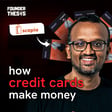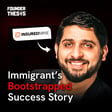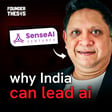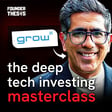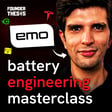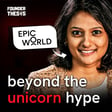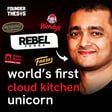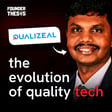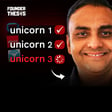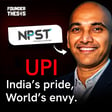Introduction and Interview with Dilip Modi
00:00:10
Speaker
Hi, I'm Akshay Hi, this is Aurabh and you are listening to the founder thesis podcast We meet some of the most celebrated sort of founders in the country and we want to learn how to build a unicorn
00:00:25
Speaker
Hi Akshay, great to be on this call with you. I'm Dilip Modi, founder of Spice Money. Tata Birla Modi. These are the names we all heard as kids whenever it came to business. And while in today's world these names seem old fashioned and traditional, these business houses are still at the forefront of India's growth story.
Building Businesses: From Spice Mobile to IPO
00:00:48
Speaker
In today's very special episode of founder thesis, Akshay Tath talks to Dilip Modi, a scion of the Modi clan and the man beyond the spice brand.
00:00:58
Speaker
Despite coming from a privileged background, he went to the journey of building not one but three businesses from scratch. He was among the pioneers in the mobile Delphinee space launching Spice Mobile way back in 2000 when he was just 21. He subsequently scaled it up, took the company to an IPO before selling it to Idea Cellular.
00:01:20
Speaker
Today, he's furthering the cause of financial inclusion and empowerment of rural India with Spice Money, which provides digital and financial services to over one crore rural entrepreneurs.
Family Legacy and Entrepreneurial Journey
00:01:32
Speaker
Here's Dilip telling Akshay Tath about DigiSpice. So, Dilip, you are, of course, from a family which has like a maybe a century old legacy of being in the entrepreneurship and business
00:01:49
Speaker
the family legacy? Yeah, sure, Akshay. So I'm a third generation entrepreneur, Akshay. My grandfather actually built a large business conglomerate, which spanned across many sectors, commodities, manufacturing and utilities.
00:02:12
Speaker
And then my father also built businesses in the space of office automation, computing. And then I've had... Modi's Rocks was one of the flagship businesses that he built.
00:02:28
Speaker
And then I've had my own journey, you know, as an entrepreneur. The common thing amongst all of us has been that all my grandfather, my father and myself have all been entrepreneurs. But the way I would see it is that
00:02:44
Speaker
In effect, we've all been first generation entrepreneurs in terms of the fact that we've not run any of the businesses that the previous generation has built. So I think while I'm a third generation entrepreneur, it's like entrepreneurship runs in the blood. But effectively, we've all built our own businesses. And it's coming from the belief that anything that you build has to be with your own passion and belief. And sometimes they don't match with someone else's.
Education and Early Career in Telecom
00:03:14
Speaker
You would have had a very unique kind of a childhood, I'm guessing, being part of a
00:03:20
Speaker
like a family with multiple businesses running, what was that like, you know, compared to most of us who grew up with a father who would have a nine to five job, like what was your growing up experience like? So, you know, if I recall, my whole childhood has been more, you know, away from home. So so effectively, I grew up in boarding school. And, you know, after I finished my schooling, I ended up
00:03:47
Speaker
Was it a tough adjustment living without parents? Well, you know, it was a tough journey. I would say they were good and bad. Right. The fact that I started very early, you know, they say that, you know, it's like putting the baby out of the bath water. Right. So I was very, very young. So very excited to, you know, be amongst kids my age and, you know, and doing things together and living together and all of that.
00:04:17
Speaker
So I would say that it was so early that it was not like I was used to things at home which were new to me and I was missing out much. But yeah, I just adjusted to it very fast. I was always inclined to do engineering and that's what I charted out to do.
00:04:40
Speaker
But I guess, you know, destiny has its own ways. So, you know, while I worked very hard, I would say I didn't manage to get into IIT, but I did want to continue to pursue my dream for engineering and all of that.
00:04:57
Speaker
I ended up going to the UK because I realized that if I want to do something, I want to get into a good school.
Entering and Expanding in Indian Telecom
00:05:05
Speaker
So in the UK, you have very specialized colleges. And one of the colleges that I picked up was Brunel University, which was known for science and engineering. And I was very keen to pursue my dream for electronics and computers.
00:05:20
Speaker
And so I ended up joining Brunel, and I did my engineering from there. And then I was always keen to also go to the Imperial College of Science and Engineering in the UK. So what happened is that post my bachelor's, I also got an opportunity to go to Imperial, and then not only finish on wanting to be there from an engineering point of view, but also pursue master's over there.
00:05:49
Speaker
And so I did my MBA from the business school at Imperial. But why did you move out of engineering into management? Well, I guess, Akshay, do you know what happens is when you grow up in a business family, what happens is that every conversation in the family is around business.
00:06:11
Speaker
And so whenever you're having conversations, which is about companies and businesses and products and services and profit and loss and all that, for me, it was something which I just grew up in. And I just thought to myself that,
00:06:33
Speaker
What are the set of core skills I want to build in myself? Because I did not pursue commerce and accounting and all of that, I thought that if I've gone up and I've worked through the science and engineering side, I should also add more skills to myself in terms of business, economics, accounting and all. That's the reason I went for a post-grad management program.
00:07:01
Speaker
It just allowed me to just learn more about different streams. And so I decided to, you know, to combine engineering and management. And you were clear that you would come back to India or were you like open minded about staying in the UK? You know, there was there was stuff happening on campus. But actually, I was very young, right? Like the reason the reason I did that one year program at Imperial
00:07:28
Speaker
is because I could do it at the age of 20. Had I decided to go to any MBA school in the US or something like that, it would mean more years of experience and all of that. And because I guess I just wanted to keep moving, I ended up doing it there. And I guess for me,
00:07:50
Speaker
Somehow the thought of working in the UK or outside India, I don't know, somehow it did not come to me. I just thought that, I guess I was just so much focused on my studies that really what I'm going to do in terms of job or build a business or do something, I didn't think about it too ahead of time.
00:08:14
Speaker
But it so happened that when I finished my graduation, at the same time, India was opening up to telecom.
00:08:24
Speaker
And the government was looking to issue these new licenses in telecom. And I still remember a call I got from my father, which said that the government is issuing telecom licenses. And this is a completely new industry. And since you are in the UK and you're working there and engineering and all that, why don't you think through whether this whole mobile telephony
00:08:51
Speaker
is an interesting space. And now it seems like obvious, but way back then it was very, very new. My dad had done this partnership with a company called Telstra from Australia, and they had got this license to run a mobile telephone business.
00:09:14
Speaker
And so for my father, it was more like, we've done this, but really, I don't really know whether I want to do this business. And so he was running his own set of businesses and all of that. And then he was like, would you want to give this a shot? Because if you do, then you would have to raise capital for it. You'll have to figure it out and all of that.
00:09:39
Speaker
And so I recall from UK, I actually straight flew to Australia. And I spent four months in Australia with Telstra, just understanding the way they operate, the business, and all of that. And then after that, I spent a lot of time trying to figure out what we need to build this business.
00:10:02
Speaker
And before I realized it, I was working with them in the city of Kolkata to build a mobile phone network business. So how did Modi Telstra become spice Telstra? So what happened is that Telstra started facing challenges back home in terms of their competitive landscape.
00:10:20
Speaker
So their main competitor Optus, which was promoted by Singtel from Singapore, they became very active in Australia. So Telstra took a strategy to focus back on their home market. So they decided to exit all their overseas markets, and they changed their management team to make the shift.
00:10:42
Speaker
So as part of that, the group CFO of Telstra spoke to us saying that they have to exit out of India as well. And so under the shareholders agreement, we had a right of first refusal. And so we had an option to buy out their shares.
00:11:00
Speaker
And that started the journey of Spice Telecom because we ended up getting private equity to give Telstra an exit. And that's the time when we decided to rebrand the network because we no longer had the Telstra brand.
Investment Challenges and National Expansion
00:11:17
Speaker
And we thought of our own brand called Spice. And so we decided to brand the network Spice Telecom and bid for you. How did you navigate the investment scenario? Like you said you got in private equity funds and all that. How did you navigate that? I mean, you obviously, at 25, you
00:11:41
Speaker
I have not seen those kind of things. How did you manage all that? Akshay, what happened is that at that time, it was a very new industry. And while this industry was new to India, it was not new to the world. So a lot of investors had made money in this industry in other parts of the world. So when this industry started opening up in India, investors started looking at this industry in India.
00:12:08
Speaker
So we were very fortunate that we managed to not only us reaching out, but people were reaching out to us. And as a result of that, it was a two-way street. And especially when these new licenses were being issued of the states, the incumbent operators who were operating in the metros
00:12:33
Speaker
Right. They became the logical targets to create vehicles to expand. What happened is that the government decided to issue national licenses. Okay. And they only decided to issue two. When is this? Around 2001 to 2002. Right. At that time, they only decided to issue two licenses for the whole country.
00:13:01
Speaker
So imagine from issuing two licenses per stake, they decided to issue two licenses for the whole country. So in fact, it was the luck of the draw, right? And because now you had like nine, 10 players in the country all vying for two national slots. And it was very clear that whoever secures these two slots, right, will become the consolidator.
00:13:28
Speaker
right? Because then you have national versus regional and the way economics work in telecom, it's a scale business, right? And you can't be viable without scale, right? So at the end of the day, what happened is that as you're aware, Airtel and Hutchison, you know, ended up securing those two slots to roll out national networks. Otherwise, all of us were regional operators.
00:13:54
Speaker
And so I remember my meeting with Mr. Mittal. It was two days before the bidding was to happen. And he told me, he said, Dilip, I have two options. Either I bid for the new license or I buy your network. And I was very clear that in the city of Calcutta,
00:14:20
Speaker
Right. The market is not big enough to have more than two operators. Right. So so if you have like more than two operators, someone will bleed. Right. And so in my mind, it was very clear that instead of bleeding, it is better to unlock value. Then what happened is our investors, because like I said, they were facing pressures in their home market in Hong Kong. So they so they wanted to exit India.
00:14:47
Speaker
And so, because they wanted to focus on their home market, and so we had to arrange for capital to give them an exit.
00:14:55
Speaker
And so it was very tough, right? Because here now, you know, we've exited Calcutta, you know, or literally then we are exiting and, you know, we just got these two circles. There are national licenses that are rolled out. And I just thought to myself, I said, you know, this is a crazy situation, right? Who would give me capital to buy, help buy out my investors, right? In a market that is getting consolidated, right?
00:15:23
Speaker
And as things have it, sometimes things have their way of working out. And I remember being introduced to Telecom Malaysia, the operator out of Malaysia, the leading operator from Malaysia. And I remember having a meeting with them.
00:15:43
Speaker
And the first thing I walked in and I said to them, I said, guys, you know, I'm not a national player. I'm a regional player. And I remember the CEO telling me, they said, Dilip, what is the population of Punjab? Right. And I said about 55 million people. And they said, what is the population of Karnataka?
00:16:02
Speaker
I said 85 million people. So they said that is like 140 million people, right? What is the population of Malaysia? As I said, 25 million people, right? So they said, you have your answer, right? So their thing was that, for us, it's not about national or local. The question is that if every market can support two operators,
00:16:31
Speaker
You know, maybe one of them can be regional, right? Because India is not one market, but multiple markets. And so, yeah, we are excited. We have to come to India, right? And, you know, things can, you know, we like what you guys are doing. We like the brand. We like the story. And we'll come and work with you, right?
00:16:52
Speaker
And so they ended up investing. We ended up doing a partnership with Telecom Malaysia. I managed to give an exit to all my investors. And like we started our journey with Telstra, we kind of ended it with Telecom Malaysia. So in fact, in a way, in between, we got private equity.
00:17:12
Speaker
But we finally ended up with a strategic operator that was Telco Malaysia, right? And then we took the company public because then we said, okay, now if you want to raise money, we have to go public because where else do we raise money from?
00:17:28
Speaker
So we took the company public, we listed it. So when we were going public, I remember we had making the storyboard and all of those things. And then, you know, Telecom Malaysia, and we were doing road shows and all of that stuff. And just after we closed, you know, we had this issue of
00:17:47
Speaker
you know going national right and we had also started procuring some licenses and all that and so we we got a bit from idea cellular right to to to buy our our business right because interestingly in their footprint the main two states they were missing out in the 900 megahertz spectrum was Punjab and Karnataka
00:18:12
Speaker
So they said that they would like to buy our business, right? And then we had a board meeting and we sat down and we discussed it. And we said, okay, guys, we have two options, right? Either we roll out an organic network across India or we merge with IDA Sanura, right? Punjab and Karnataka. And we end up becoming a part of an all India network.
00:18:40
Speaker
Right. Because idea was building a national footprint. Right. So we said, OK, two options. And then that's where telecom Malaysia guided me that, you know, we should we should merge rather than build because because the government had issued like nearly 10 national licenses. So so, you know, they said very clearly that the economics doesn't work out. Right. It's better. It's better to
00:19:10
Speaker
be part of an existing network rather than go out and build an organically new network. It will just consume more capital and the intensive and the competition.
Exiting Spice Telecom and Strategic Shifts
00:19:20
Speaker
So if you recall, many of the new players who got licenses, most of them ended up shutting down their business. This merger happened at the eve of your IPO. It was very interesting.
00:19:36
Speaker
I was in a roadshow. I remember I was in the UK and I was making presentations and I got a call from a banker. And so it was very funny. I was having two conversations, an IPO conversation and a merger conversation.
00:19:52
Speaker
And it was going in parallel, right? And I was so confused in my mind, saying, should I take this company public or should I just sell it? But I think we had just gone down so far in the roadmap of taking it public that we decided to list the company, right? But because we said we have to list it, because if we don't list it, we've just committed mid to mid. Like we had gone way down the whole roadmap of listing the company. Plus, merger discussions can fail, right?
00:20:21
Speaker
So we said that let's not wait for those negotiations to close because if we wait and it doesn't happen and we don't go public, then we lose out the opportunity. But as part of those negotiations, it so happened that because IDEA cellular was backed by the builder group,
00:20:42
Speaker
And they were already there as a strong Indian player. I decided that there was an opportunity for us to take a cash exit rather than take shares because there were just too many of us in the room.
00:21:00
Speaker
And so, I guess July 2008, you know, I exited the mobile network industry, you know, through a strategic... When did the IPO happen? I think it was just a quarter before. Okay. Okay. So, 2008, both IPO and... Both happened simultaneously. And as things have it, Akshay, September 2008, October 2008, Lehman Brothers happened.
00:21:25
Speaker
And the whole global economy went for a toss, right? Yeah, so my journey started in 1996. Finally, in 2008, I ended up exiting the mobile network industry in July 2008. OK. So what next then? From running a large organization to now
00:21:55
Speaker
Like, I mean, what did you do next? So, so very interesting. So now what happens is that, you know, like when you're running a telco business, right, it's a very prominent business. Excuse me. So.
00:22:11
Speaker
Because, you know, this is the only thing I'd ever done. You know, for me, the natural thing was, you know, what do I do something which is connected to this, right? Because in my mind, the whole idea was that this is all I know, right? Like, I'm living and breathing telecom, right? Every day, right? So,
00:22:31
Speaker
What are the other opportunities I can build around this? So rather than go into a completely new industry, what else can I do within this industry? And I remember we had some strategic consultants that we then started engaging with. As a strategic investor, what started happening is when we were building Spice Telecom in Punjab, Airtel had launched in Punjab.
00:22:55
Speaker
as a national player and they came in with all guns blazing in terms of offers and campaigns and all of that and here's a big national player coming to Punjab and here we are a regional player trying to compete.
00:23:13
Speaker
So you can imagine that David versus Goliath story kind of thing. So we had to survive and we had to thrive. So it so happened that blessing in disguise, I started looking out for ways to differentiate.
00:23:32
Speaker
And it so happened that I came across this new dual SIM technology, right? Where at that time Nokia and all these mobile phone companies only had single SIM on their phones, right? But I found out that in China, you know, there is this dual SIM technology where in a single phone you can have two SIMs.
00:23:54
Speaker
So we ended up importing our first batch of dual SIM phones from China.
Focus on Spice Mobile and Digital Services
00:24:01
Speaker
We branded them Spice. And we ran an offer which said to all Airtel customers that use Airtel in the day, use Spice in the evening. And it's free. So we ended up because our network was relatively free in the night time.
00:24:23
Speaker
So we had this campaign run where we encouraged all the Airtel customers to take a Spice phone, put their Airtel sim in one slot and the Spice slim in the second slot and use it in certain hours where we gave them free calling.
00:24:42
Speaker
right and we saw a huge rush of you know especially youngsters you know and all these guys you know who wanted to talk late night and all those things you know these night packs and all that stuff and it became a huge success right and you know what started happening is they started giving that number out as well and that time there was no number portability so so because of that we started getting some traffic in the daytime also
00:25:08
Speaker
So it actually became a very viable model. So what happened is within Spice Telecom, we created a handset vertical, right? And we called it Spice Mobile. And because the brand, the customer was the same, right? Like we were targeting the Spice user and we were trying to churn the user from Airtel to Spice. So the brand was Spice, right? So we started this vertical within Spice Telecom.
00:25:38
Speaker
And then when we sold Spice Telecom, the buyer was not interested in this business because they said we don't want the phone business. So we ended up taking over that vertical. And then we realized that this is an industry of its own.
00:25:59
Speaker
dual sim mobile, right? And this I'm talking like, now you're talking between 2005 and 2008, right? So, we launched India's first dual sim phone in 2005, right? Kind of a thing under the brand spice mobile, right?
00:26:21
Speaker
So in 2008, when we sold our business, by then in China, 50% of the handset industry was taken over by the dual sim manufacturers. Like today, you know them, right? Oppo, Vivo, Huawei, all these guys, right? And India was still a Nokia market, Nokia and Samsung.
00:26:44
Speaker
Right. So then we realized that here's maybe an opportunity that India will replicate China. And so we said that, you know, let's grow this business. So, you know, we said, OK, we'll build this dual sim phone business and continue the spice brand.
00:26:59
Speaker
And then instead of just selling in Punjab and Karnataka, we will sell across India. And because the brand was no longer a telecom brand, we kind of said, okay, it's logical, diverse logical extension of the brand. Because from Spice Telecom, we became Spice mobile.
00:27:19
Speaker
There was a little difference where customers were thinking of us in Punjab and Karnataka as a network brand. But outside Punjab and Karnataka, people didn't see us as a network brand. So to that extent, we said, OK, there's some overlap in Punjab and Karnataka, but maybe the larger opportunity is bigger. And so then Spice Mobile became a line of business that we had an opportunity to think of post-selling Spice Telecom. And there was this other business that had started which was called
00:27:49
Speaker
you know, Spice Digital, which was basically, you know, we used to build a lot of content and application work in Spice Telecom, right? Like, you know, like value added services. And so what happened is that, you know, after selling Spice Telecom, there was no conflict of interest with other telcos.
00:28:09
Speaker
So then we thought that our IT team, our engineering team can also now build solutions for all telcos. So these two became our spin-offs. And it was called, I remember, Celebrum Technologies at that time. So later it was Spice Digital. At that time it was called Celebrum Technologies. So Spice Mobile and Celebrum Technologies became the two spin-offs.
00:28:38
Speaker
And so when I sold my network business, I immediately started seeing what is my opportunity to now scale up, both in terms of the dual same hardware business as well as the value added services business for telcos. So I immediately jumped from running Spice Telecom to thinking of these two businesses and what should I do to scale them. So it kind of was a related journey, but a new journey. When I moved from infrastructure
00:29:06
Speaker
to hardware and services, right? That's the new journey that I started in 2008. So, 2008 you sold the telecom business and you had Spice Telecom as one venture to scale up and you had
00:29:24
Speaker
Spice Digital as the other venture to scale up. So tell me about the journey. So we had Spice Mobile and Spice Digital. Effectively, Spice Telecom was an infrastructure business and Spice Mobile was a hardware business and Spice Digital was a services business. So I continued with the brand Spice in the consumer space through the hardware business.
00:29:47
Speaker
And the reason we branded the services business as FISE Digital, because our main customers were telecom operators. So that helped us. And we ended up then focusing on these two businesses, Akshay. And so one of the things that happened is next is
00:30:05
Speaker
As we thought about building these two businesses, one of the things I also realized is that when you build a business, competition can come from anywhere. At the end of the day, you have to understand that are you part of a local playground or a global playground?
00:30:26
Speaker
When we thought of the mobile hardware business and the services business, we realized that geography, there's no limitation to geography here because it is not about regulation, right? Like telecom was heavily regulated, right? So the reason we could not go national is because the government decided to issue only two licenses at that time. So now we were in relatively unregulated spaces and here competition can come from anywhere.
00:30:51
Speaker
And so we said now we want to scale, then we have to think not just about India, but like at least regional, if not global, because now you're competing with Nokia, Samsung, right? And in the services space, you can go anywhere, right?
Transitioning from Feature Phones to Smartphones
00:31:07
Speaker
Like all these IT service companies, right? They serve customers globally, right? So we said that, you know, why not think outside India?
00:31:15
Speaker
And that is the time for both these businesses. We started envisioning not just an India strategy, but a regional strategy. And yeah, but it always started with hiding a country manager. And what were the services? So we started. So what happened is that, you know, if you look at telecom networks, right, the main product is voice and data. Right. But then but then they also want to build other services. Right. Because they are these big pipes that can
00:31:44
Speaker
through which content can flow. So the first set of services that we enabled for telcos was content services. So for example, music streaming, gaming. So we built a lot of music content related services, a lot of portals, games, so a lot of entertainment content. So we ended up going to a geography like Africa,
00:32:12
Speaker
and partnering with all the local content providers and bringing them on a platform so that the telco could then launch a service for their customers.
00:32:26
Speaker
Like a WAP portal? So initially it was not even a WAP portal in those days because internet was still picking up, right? Internet connectivity. So initially it was an IVR portal, right? An interactive voice response where our flagship product was called mobile radio. So you're listening to music by dialing a number.
00:32:47
Speaker
So our flagship product was we used to host music content on a server and people were dialing into that server and then they could choose the song they want to listen to and it was basically getting into the radio business right using mobility.
00:33:03
Speaker
And then we moved to web portals and now we are doing apps. So as the telcos have invested from voice to data to video, we've also graduated in terms of building products and services to them.
00:33:21
Speaker
So now you're doing apps for telcos or apps for any like any startup or anybody because I mean telcos are not really investing in apps. Yeah so so there's a difference of India and other markets Akshay. So what is happening is like like in India you have Airtel doing the wink music app.
00:33:41
Speaker
That is an app from the ETL family and you see players like GEO having bought out Savan and they are doing the GEO Savan app. So similarly there are many telcos in Asia and Africa who are wanting to have their own suite of apps.
00:33:59
Speaker
So we are working with telcos in those markets, right? Where now we are working with them to not only build the app, but the UI, UX, the whole content management system, all the digital components, right? And again, running it as a managed services model for them.
00:34:15
Speaker
Whether it be Indonesia or countries in Africa, now we are doing it. Now this company, Spice Digital, Akshay, is today what is called DigiSpice Technologies, which is our main flagship company, which is a journey right now. Between 2008 and 2018, while we kept building Spice Digital,
00:34:42
Speaker
We really focused a lot also on the hardware business, you know, Spice Mobile. And if you recall, during that time the leaders were players like Nokia, right? Like we were a Nokia country, right?
00:34:56
Speaker
and the same applied to Asia and Africa. These were all Nokia markets because it was all feature phone and all that. So I remember at that time when we went outside India, we decided that we will build a very significant play like we'll be a number two to Nokia.
00:35:17
Speaker
But a very strong number two driven by dual sim and a lot of focus on industrial design. And if you recall the Nokia phones at that time, they were mainly those bar type phones with those keypads. Gray in color, black in color.
00:35:36
Speaker
But coming out of China, we had all these flip phones. We had colorful phones. So a lot of focus on industrial design. And then internet connectivity had just started. So we had the browser coming into the phone. So we could build portals embedded in the phone. So a bit of services. So a lot of our Spice Digital stuff, we were working for telcos. We started integrating those services in our Spice mobile phones as well.
00:36:05
Speaker
And so when we grew outside India and we combined the India business, our strategy was that we will build a parallel to Nokia, right? But be more like a local champion, right? And at the same time, you would see companies like Micromax and Carbon and Lava. Many of these companies also came up in India and similar companies came up in the other regions.
00:36:28
Speaker
But then what happened is that business required a lot of investment in terms of inventory and branding and all of that stuff. And when the technology moved from feature phone to Android, that's when a lot of companies fell off the cliff, including Nokia. And Samsung wrote the Android wave.
00:36:52
Speaker
So I remember Nokia went the Microsoft route and all that. So for us, the shift from feature phone to smartphone is one shift that we as a company could not manage because we had invested a lot in inventory across Asian markets.
00:37:15
Speaker
So I remember at that time we had over a million smart feature phones, right? That we had to write off on our books, right? And it was a huge impact on our balance sheet and all of that stuff. So that was a big learning for me, right? That we had this great ambition, which we were chasing, but we got hit by this technology shift and we could not
00:37:41
Speaker
We could not manage that, right? And we ended up going through this very difficult restructuring phase, right? Because when you have balance sheet and write-downs and all that, losses and all that, you go through a lot of pain, right? A lot of Indian companies survived that pain because they were only India-focused. While we had diversified geographically into Indonesia, Malaysia, Thailand. So the pain was bigger, right?
00:38:09
Speaker
So we decided that now how should we look at it? So there came another point of inflection. What was the lesson for you in that? So I think the biggest lesson for me Akshay was that sometimes don't try to take
00:38:31
Speaker
a big leap when it comes to trying to build a business. I think the biggest lesson for me was that go at it step by step. For example, we thought that we could differentiate ourselves in the market by moving from a basic feature phone to a full screen smart feature phone. And we bet the company on that strategy.
00:38:57
Speaker
because we built out nearly a million phones in that strategy. In retrospect, I would have taken a smaller step. For example, instead of a million, I may have done like 100,000.
00:39:11
Speaker
I would have first explored and seen whether it works or not. And if it works, you scale it, right? So to me, the biggest thing was that when you're building something new, pilot it, take that baby step, test out the market fit. And when these shocks come, they don't hit you that bad, right? Because you kind of ring fence that bet.
00:39:36
Speaker
Right? But we were like these charged warriors out there and there was this kind of we can go and get it and all that and we didn't see this tsunami coming. Right? So sometimes just while this aggression is good but you just want to make sure you don't beg the house.
00:39:58
Speaker
And my biggest learning was never to bed the
Pivot to Spice Digital and Emergence of Spice Money
00:40:01
Speaker
house. So today, it's definitely helped me through my journey now, where every time I need to take a big decision on something new, I try and take it one bite at a time, rather than take a huge big bite at it. And then tomorrow, I don't know whether I'm bedding the house or not.
00:40:25
Speaker
So that was my biggest learning out of that action. Because of that we ended up facing a huge financial challenge and we had to shut down our business of hardware outside India.
00:40:41
Speaker
In India, we still had a good business that was running. But when you end up taking that kind of pain, your view on the business starts to sour. You don't know exactly whether you can make it, not make it, and all that stuff.
00:40:58
Speaker
and so we decided that you know let's just focus on our services business right let's let me try and scale up this let's see where we can take this business right and we've learned from this journey but let's see you know let's build a new business so while at spice telecom you know I managed to take the company public and finally got a good exit
00:41:23
Speaker
In the spice mobile case, it turned out to be a journey where I had to shut down the business, which was a different experience. I remember...
00:41:34
Speaker
spice retail outlet multi-brand retail outlet yes so what happened there was that you know we had this you know which was part of the spice mobile business so so what happened is that as we were building out spice mobile akshay we we also you know rolled out these spice stores right which you know were initially to support the spice mobile phone business because you see everyone was stocking up Nokia phones
00:42:03
Speaker
So how do we get people to experience the spice phones? So we ended up setting up our own stores. And that is where Nokia had their own stores. We ended up building our own stores. But because customers coming into the stores in Nokia were only looking for Nokia phones because they are 90% market share, we had to show them all other phones.
00:42:27
Speaker
So those spice shops became multi-brand but they were effectively part of the spice mobile journey. So obviously when we shut down the spice mobile business, we ended up exiting from that retail business as well because it was very much part of the mobile business.
00:42:47
Speaker
So I didn't talk about that because that was really part of that overall journey that we took at Spice Mobile. So while my first company, we did a strategic exit, the second company we had, it didn't work, we failed and we shut down the business. And then we were left with our services business.
00:43:08
Speaker
we were working with Telcos and then we said we want to diversify and do more in this space. And that is a business that we started building. And I think it was really in 2014, 2015, right? When I really started focusing full-time on Spice Digital and we started seeing what more we can do in this business. Now, of course,
00:43:37
Speaker
When you look at the services space, there's so much in terms of not just working on digital platforms for telcos, but you can become a digital platform and solution provider for so many industries. And so when we started looking at this business, we said, OK, we understand digital. We understand apps. We understand digitization as a concept. How can we take this experience to other industries?
00:44:07
Speaker
So we started moving out and looking for other opportunities in other spaces. We're very proud that one of the projects we got was from the government of India to build a G2C app called Uman. So Prime Minister Modi, in 2014, when he took power, he brought in this digital India vision.
00:44:31
Speaker
And as part of that vision, he wanted to digitize all government to citizen services. And the IT department envisioned this mobile app called Umang, which stood for, I think it was a unified mobile app for UH governance.
00:44:47
Speaker
right? Umang, right? And it was an RFP. So we had spies digital bid for that. And we managed to win that RFP. And so we ended up building the Umang app for the Government of India.
00:45:01
Speaker
So that became our way to start our digital platform journey. So we started working with banks. We started working with insurance companies. We continued our journey with telcos. And then really, Spice Digital became this playground for trying out a lot of new things. And not only building solutions for
00:45:28
Speaker
government, but also for other enterprises. And Spice Money, which is the FinTech business that we are building today, was a project that got born out of Spice Digital. And this was one project that got seeded, so we had lots of projects being run as an incubation in-house.
00:45:49
Speaker
and this project got born in Spice Digital and later got spun off as Spice
Expanding Financial Services in Rural India
00:45:58
Speaker
Money. What was the idea behind it, Spice Money? So what happened is, Akshay, one of the things as we were rolling out, again, learnings out of the telecom business, we realized that the mom and pop stores that are selling these recharge vouchers,
00:46:20
Speaker
are at some stage going to get digitized.
00:46:24
Speaker
Right. Because we knew that smartphone penetration will grow. Internet penetration will grow. So the traditional distribution of telecom will also go digital. Right. So we said, why don't we build an app? Right. For the merchant. Right. Where he can he can buy recharge using the digital platform rather than traditional. Right.
00:46:51
Speaker
So the journey started as a project for that. So amongst many projects we were doing, this was one very, very small project that was happening, which was like a digital recharge platform for a merchant. And we started that as spies digital. And then before we realized it, once we got him to use our web and app,
00:47:13
Speaker
to recharge, right? We realized that we could also enable other services on them, right? And so the next service we started was remittances, right? Because most of this recharge platform got adopted first in bigger cities, in urban India.
00:47:32
Speaker
Right. So because they were the early adopters of digital. Right. So they they they we could enable on the same platform that when people were coming to recharge at their shop, right, people could also come at their shop and give cash to to send back home in rural India. Do you know a lot of a lot of workers, laborers and all that sending money to rural right where where you you come somewhere to deposit money to put cash to bank.
00:48:01
Speaker
Right? So, suddenly from recharge we added remittances as a product. Right? And we saw that really pick up. Right? This is also how Vodafone's M-Pesa experiment worked out, right? They had something similar. Exactly. So, that in fact became the genesis of what is called payment banks.
00:48:22
Speaker
So then RBI came up with this whole licensing around payment banks. That's why you see Airtel payment bank, Geo payment bank, because it all started on the back of their recharge merchant. So we saw the remittances use case really pick up Akshay. And I remember a meeting I was sitting and we were reviewing many projects and this was one of the new banks.
00:48:46
Speaker
We were reviewing and I remember the team that was leading it, you know, they just walked in the room and showed me a hockey stick, right? Like they just showed me like, you know, last quarter we did X and this quarter we've done like 2X, right?
00:49:01
Speaker
And by the way, the next quarter, we're going to do 4X. And I was like, guys, what are you doing, right? Like, who are you? What are you doing? And they were like, we're doing this project. So suddenly they got excited because they're like, you know, something is happening. Right. And I'm like, come on, guys, you know, this is like one of the projects I do. I was thinking more like building and building all these big projects. And suddenly I see this hockey stick. Right. And that, you know, I think they had half an hour in the meeting for presentation.
00:49:31
Speaker
and we cancelled all the other presentations and we said, okay, let's understand what's happening here. So, then we dug deep, right? And we realized that, you know, this could be an industry of its own, right? An opportunity of its own. And then the biggest thing which convinced us that this is a play of its own is what started happening, Akshay, was that when people were sending money back home,
00:49:59
Speaker
Right? Then people are going and withdrawing money. But then the third product that came was APS. Adhar enabled cash withdrawal. Right? So what started happening was, one was remittances, the other was withdrawal. So what started happening is, when we enabled the APS product on our platform, we saw a whole different profile of merchants.
00:50:25
Speaker
Sign up to our platform. And most of these were from villages in rural India. Because that is where the money was going. And then people were coming to the shop to withdraw cash. So what was happening in the remittances product, that people were going to the shop to send cash. And what was happening in the withdrawal product, people were coming to the shop to withdraw cash. So we saw that that product
00:50:55
Speaker
had also begun to scale. Right? And that is which... How does that work though? Adha are enabled to cash... So it's very simple. The bank account linked with that adha... Yes, it's very simple that now most bank accounts are getting linked to the adha. So what happens is that in villages now, Akshay,
00:51:16
Speaker
while government opened 300, 400 million Jantan accounts and they sent the subsidies directly to the account. A person has two options to withdraw cash. Either he goes to his nearest ATM or a bank branch, which is quite a distance. Or he goes to a local merchant which is onboarded on a digital platform like ours. And he authenticates himself using Adhar.
00:51:43
Speaker
And through our platform, we enable the money to move from his account to the merchant's bank account. And the merchant pulls out cash and gives it to the customer. So that's how it works. It's very simple. So it's riding on the Adhar stack.
00:52:00
Speaker
So, when we saw these remittances and ATM use case pick up, then we realized that, you know, guys, now this is like a blue ocean, right? Because in urban India is one opportunity. But the moment you get into rural India,
00:52:16
Speaker
Right. Can we grow on the back of this use case of a digital ATM? Right. And that's what convinced us that this has legs of its own. And we decided to spin this business off and brand it as spice money. And we said we're going to chase the rural consumer with a platform which can enable them to deliver financial services. When did this bit of happen? So this happened
00:52:43
Speaker
two and a half years back. How big are each of these businesses today? So we are still very young in our journey, Akshay. This I would say is what I call my third leg of startups. I would say like Spice Telecom, Spice Mobile, Spice Digital. My first and second. This is my third journey in my entrepreneurial journey. And where we are is that
00:53:12
Speaker
If you look at our numbers, last financial year, we did a turnover of over 700 crores. I have a question. How did the merchant onboarding happen? How did merchants discover you? Or did you have a team of people who were out visiting villages and signing up merchants? How did that happen? So we, of course, had our in-house project team which was doing this work.
00:53:37
Speaker
which was meeting merchants, the early adopters and trying to figure out. But the early adopters are more in big cities, you know, for the recharge remittance use case. Obviously, this must have been like almost like a decade back, the recharge remittance use case. Yeah, so I think this project must have been
00:53:59
Speaker
Yeah, I think a decade back was 2012-13, you know, kind of a thing. So, you know, they played around with this product and all that. But I think it was around 2016-17 when we saw this really pick up, right?
00:54:13
Speaker
The adhar integration happened. Yeah, with the bank account and all that. So you had that legacy set of merchants who were using it for recharge and remittance. Yeah. And this was maybe with whom you piloted adhar. Correct. With whom we piloted. And then, of course, as adhar seeding into bank accounts grew, the adoption of this platform with merchants grew.
00:54:36
Speaker
Was it organic, like spreading through word of mouth? It was organic but then we also had a distributor layer. So we started appointing distributors as partners in different geographies and they played a role of onboarding merchants for us.
00:54:52
Speaker
So they used to have feet on the street that used to go out and identify merchants and send us their documents and we used to help onboard. And this is a business we had learned in Spice Mobile, appointing distributors who appointed merchants.
00:55:09
Speaker
The only difference was that they were buying a product like a phone and selling it to the merchant. Here, they were getting us merchants onboarded onto our digital platform, which is web and app. But effectively, the aspect of having distributors in every geography was something that we had done at Spice Mobile.
00:55:32
Speaker
And a lot of these distributors were like telco distributors, airtime distributors, who had access to the larger merchant network. Because the distributors of the telcos are like the FMCG and the tobacco company distributors. They have to make recharge available even at the pawn shop.
00:55:56
Speaker
So to that extent, we were able to tap into that distributor network. And then they started helping us onboard merchants. And also, because the product had a pull.
00:56:09
Speaker
because wherever there was no ATM machine in a town or a village, the merchants saw a use case where they could suddenly solve a problem for the customer. So instead of traveling a distance to find an ATM machine, the customer could withdraw cash at that merchant point. So I think it was basically the use case that also drove the adoption.
00:56:37
Speaker
Okay and how does the P&L of the merchant look like and the distributor like what is the upfront payment they make and then what do they look like?
Transforming Rural Banking and Platform Growth
00:56:47
Speaker
So this is a complete transactions led business model so do you know more than payments and all that I think upfront it's more about KYC they know that they have a valid bank account, bank number
00:57:00
Speaker
But you give them a device, right? You give them hardware, biometric. So I think in the early days, we used to give them the biometric. But now most of them, because biometric is now needed for a lot of use cases, including telco. So a lot of the telcos have already given the biometrics to all the merchants. So our need to give a biometric is not required because these are all interoperable.
00:57:26
Speaker
So wherever required we give it, like in the initial days we used to give the biometric machine, now we don't. Or wherever it is required, it's available. Now what we've started giving them is a card device, right? Where in addition to using Adhar biometric to authenticate yourself, you can also authenticate yourself using a debit card. And so we've started giving them a small pin pad device which can accept a card.
00:57:54
Speaker
Like a boss machine. Because now, one thing which is there with all the bank account holders is a debit card. What they don't have is a credit card, but they all have a debit card.
00:58:06
Speaker
So basically, we grew on the back of this, and then we started layering other use cases. So at the moment we reached a village, we realized that there could be multiple use cases. So for example, if he's coming to the merchant point to do his recharge or to withdraw or send money,
00:58:27
Speaker
then he can also at that same merchant point pay all his bills, his electricity bill, his water bill, his gas bill. Again, problem of access, right? Because to pay his electricity bill, he has to go to the electricity office and stand in the line to pay their bill. So again, can he pay his bill at the nearest merchant point? So we started building a lot of payment use cases.
00:58:54
Speaker
on the bank of this. And that's how the whole spice money story started. And of course, during the last one and a half years, we have seen a 3x growth in our scale because of the need for cash in rural and semi-urban India has grown.
00:59:17
Speaker
And the government has sent a lot of money in the form of subsidies into people's bank accounts. And so the need for a network where you can go and withdraw this money. So I think we managed to set up or start this platform at the right time, because when it was most needed,
00:59:41
Speaker
We had a ready platform. You can imagine a situation that if they were not platforms like ours, and the government had to distribute subsidies during the pandemic time, and there was no ATM in the village, then how would people get access to that money? Now we are converting every Kirana store into an ATM. Because smartphone and internet connectivity has reached every village,
01:00:11
Speaker
we are able to deploy a platform on every smartphone of every kirana store in every village. So that's what I think was a very timely
01:00:26
Speaker
you know, start to this project. Tell me about the growth numbers, like what was the merchant-based pre-pandemic? What is it today? What kind of transaction numbers or revenue? So basically, you know, we were growing at a pace of about adding close to about 5,000 to 7,000 merchants a month, right? That was the pace we were going up till the pandemic. I think
01:00:50
Speaker
maybe I would say 5,000 to 8,000 merchants a month. From April 2020, when the lockdown started, our onboarding on our digital platform went up to 30,000 a month. So we went from 7,000 to 8,000 to 30,000 a month. And as a result of that, we've ramped up our network where during this pandemic time, we added over three and a half lakh merchants in one year.
01:01:19
Speaker
And so we literally doubled, we were about, what can I say, about 200, 250,000 merchants pre-pandemic. And as of today, we are close to 700,000 merchants. So we've been growing the network at an average of about 30,000 a month. And now we are getting ourselves ready for the next phase of growth.
01:01:48
Speaker
So what is the next phase? Are you going to increase the coverage of products or are you going to increase the geographical coverage? Both. So the next phase of growth is definitely around both products and coverage. On the coverage side, we have realized that while we grow organically across the country, there have definitely been pockets where we still
01:02:13
Speaker
do not have enough coverage. So our goal is that we think that we can get to at least a much bigger scale than where we are, because what is happening is there are many districts where we are densely populated. And by dense, I mean like one atm per thousand rural population. While there are many districts where we are sparsely populated. So out of 700 districts in the country, I think
01:02:39
Speaker
From a dense point of view, we are still between 100, 150 districts. So there's still about 550 districts where we can go dense, right? Because our goal is that on every street, we should have a spice money adikari, at least one, right? Because our goal is to go as close to the customer as possible.
01:03:00
Speaker
and to the doorstep of the consumer. Obviously, if you look at the nature of the market, you have 30 million merchants. How many of them can be onboarded onto our platform is the goal.
01:03:15
Speaker
So we did call out our goal that we want to get to about 10 million entrepreneurs that we want to digitally and financially empower. So that's about one crore. So against that, we are at 7 lakh. So still a long way to go. And what is that timeline?
01:03:36
Speaker
Funnest goal? Well, I just got off a call with my team this morning. I've shrunk every timeline by half. So the three year goal has already become one and a half years and one and a half year goal has become six months and six month goal has become three months. So I think we are trying to grow at the speed of the Internet economy, right? Or even faster, right? I don't know which is faster, speed of light or speed of Internet economy, whichever is faster.
01:04:04
Speaker
The second is in terms of products. I think what we are now beginning to think of ourselves at Spice Money, Akshay, is in terms of reimagining a bank branch. So now, going forward, everyone talks about neo-banks and the future being that of neo-banks, right? Where there's no branch, people are onboarding themselves using their smartphone and all that. Now, while we agree that that's the future,
01:04:33
Speaker
What we also believe that in semi-urban and rural India, there is a huge need for assistance. So I think the bank branch, as you and I know it, needs to be reimagined for rural India and for semi-urban India. And so the idea is that Denob Kanmai Adikari also, in addition to being an ATM, be a bank branch.
01:04:55
Speaker
What did that involve? When you think of a bank branch, you don't go to a bank branch just to deposit and withdraw money. You go to a bank branch for many products, you go to open an account, you go to get a loan, you go to invest in a savings product or mutual funds, or banks have also started offering insurance products.
01:05:20
Speaker
So if I think of what a typical bank branch does in terms of product offerings, and I can reimagine that bank branch at a rural merchant point. So can my rural merchant function like what a bank branch functions?
01:05:38
Speaker
That's where our next journey is going in terms of products. The idea is that how of this network we are building, how many of them can also play the role of a bank branch? We believe our hypothesis is that while we agree that the future is branchless, but what we believe is that the need for
01:05:58
Speaker
assistance in terms of KYC, the need for assistance in terms of education, the need for assistance in terms of product knowledge. All this is very paramount. So we've interacted with many neo-banks. And what we've realized is that assistance can be a huge top up. And so you can imagine
01:06:24
Speaker
that one is everyone doing everything on their smartphone. But in addition to that, if there is a place where people can go and not only transact using cash, but more importantly, get assistance on uploading the documents, providing additional KYC-related needs. And that point also becomes your point of collections. So tomorrow, neo-banks can lend money. But we know that lending money is one thing, but collecting money is another.
01:06:54
Speaker
While you can have a standing instruction from the bank account, but if you have a network on the ground that can double up in terms of all elements of loan origination, loan documentation, management operations, as well as collection.
01:07:12
Speaker
then I think this can become a huge asset. So how deep do you want to go into these products? I mean, one approach could be that you just tie up with a whole bunch of FinTechs and become a sales platform for them. Or the second could be that you actually get an NBFC license and do lending or
01:07:32
Speaker
get an insurance broker license and sell the insurance yourself. So how deep do you plan to? So at Spice Money, we see ourselves more like a rural FinTech platform business. So what we are building out is a platform business.
01:07:48
Speaker
where we will enable third party products and we will own this digital network of merchants and entrepreneurs through whom we will enable the delivery of these products to end consumers. So I think at Spice Money, we are wanting to roll out a platform business.
01:08:08
Speaker
Having said that, if we see gaps in terms of lack of credit products or lack of insurance products with third party manufacturers, there's nothing stopping us from creating other vehicles.
01:08:23
Speaker
which can help us bridge those gaps. But at Spice Money, we see ourselves as a platform business, which is working with third-party FinTechs and platforms for enabling financial inclusion within rural and semi-urban India. Would you look at acquisitions? I mean, an acquisition could be a quick way to
01:08:46
Speaker
bring in these products into the platform. So we are actually open to all options, organic and inorganic. And I think what is exciting us is to evolve around and with the rural consumer. And that's what we will do. We will also keep our eyes and ears open in terms of which are the startups who are wanting to target the rural consumer and the rural merchant. And we will definitely at the least offer them our platform.
01:09:15
Speaker
as a way to access millions of merchants and consumers in rural India and at the least, right? And we can also go as far as investing stroke acquiring them if economics works out at both ends.
01:09:32
Speaker
So these 7 lakh merchants that you have, do they get classified? Like, you know, I'm assuming they would be like 80-20. So of course, of course, because within this you have different category and profile of merchants. So for example, there are pure financial merchants who only do this business.
01:09:54
Speaker
like a 500 square feet store or a room where they are sitting with their laptop and their mobile phone and people are walking in and all that. How much would such a merchant earn? Our goal is that the merchant should earn at least 50,000 rupees a month.
01:10:17
Speaker
That's our goal with every merchant. Now, it all depends on the effort and the focus that the merchant puts on the business. Obviously, the pure financial merchants end up earning more because they run this as their core business. But the large cohort of merchants are your general kirana stores.
01:10:38
Speaker
Who would be more sitting in that whole 5 to 10,000 rupees a month kind of a bucket? So our goal is now to add more products. We have recently rolled out a travel product for the merchants. Which I think was an acquisition, right? We actually created a separate platform called Travel Union.
01:11:04
Speaker
in partnership with Mr. Sonu Sood. So there's Spice Money and there's Travel Union. And we've integrated the Travel Union product into our platform. So this was a case where we did not find a B2B travel tech partner. Like they were partners, but more B2C focused. And if they were B2B focused, it was more in urban India.
01:11:33
Speaker
not in rural India. So we ended up rolling out a B2B travel tech platform for rural India. So this is to give you an example of, you know, if we do not find a partner, we create another vehicle in which we roll out that business. And through that, we are enabling our this spice money, Adikari merchant to also become a travel agent.
01:11:56
Speaker
He can sell train tickets. I'm assuming bulk of transaction will be train ticket. Majority of the transaction is train and bus. And also going forward like accommodation, right? And then various packages and various packages. Accommodation like OYO rooms. Yeah, OYO rooms, exactly. Like not, I won't quote anyone, but like a network like OYO rooms.
01:12:22
Speaker
If a person is traveling, then how do you enable them to be able to get an end-to-end service in terms of both transport as well as accommodation and then other benefits that go with it? For us, we are rolling out multiple use cases. The financial services are the ones that are most exciting, but we also see excellent traction in products like travel.
01:12:49
Speaker
And also what we believe is another use case that we're working on is tying up with a lot of enterprises working in rural India like microfinance and others who still have a huge effort on cash collection. So now what is happening is many of these microfinance companies have a network of loan and collection officers.
01:13:11
Speaker
which go and hold these meetings in self-help groups to give loan, but they also go to collect the money. Now, when they collect the cash, because while a lot of the dispersal has got digitized, the collection is still not digitized.
01:13:28
Speaker
Right. So they have collection officers going into the village, collecting the cash and going to the branch to deposit the cash. Now, now we are trying to reduce the cost of collection by saying you know, I think I can be my collection officer in the village. So we are bringing down the cost of collections within the value chain. And we hope that that will help them bring down their cost of loan to the customer.
01:13:53
Speaker
So we are seeing such kind of use cases also build up on our platform.
Introduction of Correiro Communication Platform
01:13:59
Speaker
Okay, so let's spend a couple of minutes on Correiro also quickly. So what is, tell me about the idea Correiro. Why Correiro is exciting to us is because, you know, at DigiSpice Technologies, we've been working with large enterprises like banks and utilities to enable their communications with their end customers using mobile channels like SMS and voice.
01:14:24
Speaker
and digital channels like WhatsApp and email. So what is happening is that you would appreciate that a lot of communication with end customers of an enterprise is now moving from mobility to digital, whether it's a customer care use case, whether it is a marketing use case, whether it's a transaction use case. So a lot of banks, for example, all your OTP works on SMS.
01:14:49
Speaker
So, you have small banks, you have large banks, you have insurance companies, the need for automating communication is paramount.
01:15:04
Speaker
like to know more log on to www.digispice.com. That's www.digispice.com. This episode of Founder Thesis Podcast is brought to you by Long Haul Ventures. Long Haul Ventures is the long haul partner for founders and startups that are building for the long haul. More about them is at www.longhaulventures.com.

